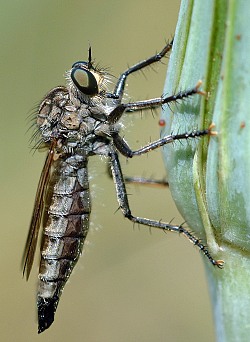
 Introduction
Introduction
 History
History
 Morphology
Morphology
 Terminology
Terminology
 Phylogeny
Phylogeny
 Distribution
Distribution
 Ecology
Ecology
 Biology
Biology
 Immatures
Immatures
 Foraging
Foraging
 Prey
Prey
 Courtship
Courtship
 Oviposition
Oviposition
 Mimicry
Mimicry
 Collecting
Collecting
 Determination
Determination
 Photography
Photography
 References
References
|
|
WOOD (1981): "Adult asilids, both male and female, are noted for their rapacious attacks on other insects, incuding stinging insects such as bees and wasps. This behavior has earned them the name 'bee catchers' (Bromley 1934). They are usually found in open and sunny habitats ranging from grassland and brush, valleys and dras, to open glades in woodland. They are seldom found in deep woods where it is dark. Their flight activity occurs mainly during the hottest part of the day. The activity-threshold temperature, though undoubtedly different for each species, is telatively high; Dennis & Lavigne (1975) set it at above 20°C for most species. Their activity is greatly reduced or absent in overcast weather, as the activity of the other insects upon which they prey. Their general habit is to perch in open sunlit areas where they presumably command a good view of passing insects, then to fly out to catch a suitable prey. Some asilids take up stations on exposed branches, others on logs or stones, still other species on the ground itself, each species showing a preference for type of perch and height from the ground.
|

Dysmachus trigonus, female |
 Dasypogon diadema, female
Dasypogon diadema, female |
Most species capture prey as it flies by, but members of the Leptogastrinae capture stationary prey while themselves in flight, as do damselflies (Scarbrough and Sipes 1973). A few dasypoginine species capture prey that is crawling on the ground (Lavigne 1963). Immediately upon making a capture, the asilid stabs its prey with its hypopharynx in the neck between the head and thorax, at the junction of thorax and abdomen, through the eyes, or between the sclerites at the end of the abdomen (Dennis and Lavigne 1975, Scarbrough 1978). The prey is then injected with saliva containing neurotoxic and proteolytic enzymes, which rapidly immobilize the prey and liquify its tissues; in a relatively short time the asilid is able to suck out the contents."
|



|
|